My initial exposure to the Mosin-Nagant rifle occurred when I saw the movie Enemy at the Gates a few years ago. At that time, I didn’t know anything about Mosin-Nagants other than I had seen them for sale at ridiculously low prices in Big 5 sporting goods stores. I never took Big 5 as a serious gun store (I went there when I needed jogging shoes), nor did I think of Mosins as interesting rifles. But Enemy at the Gates got my attention. It was very well done, starting with the opening scene when Vasily Zaitsev nailed a wolf with a Mosin, and progressing to the now famous “Can you shoot?” scene near the beginning of the movie.
Enemy at the Gates was set in Stalingrad. I studied that battle. Stalingrad was one of the world’s epic struggles. Hitler sent two million men into Russia; fewer than 3,000 returned to Germany. Incredible and awesome stuff, and snipers played a key role in turning the tide for the Russians.
Please click on the popup ads…it’s what keeps us going!
I didn’t run out and buy a Mosin-Nagant after watching Enemy at the Gates, but the seed had been planted. I also knew a bit about the history of modern sniping in the US military. I read a book a few years ago about Carlos Hathcock, our famous sniper of the Vietnam War (that book, incidentally, is awesome).
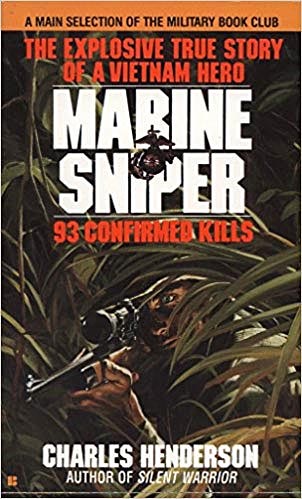
So, fast forward, and my interest in rifles ultimately extended to the Mosin-Nagant. I purchased my first Mosin-Nagant (a round receiver Tula; more on that in a moment) and I was impressed with it. For $179, it was cheap fun. I started reloading 7.62x54R ammo for the Mosin after I bought a couple of boxes of factory PRVI Partizan ammo. The PRVI ammo was stupid hot, not very accurate, and I knew I could develop a better load than the factory stuff. And I did, but that’s a story for another blog.
I told my shooting and riding buddies about my Mosin and how much fun I was having with it. After listening to me babble on, my friends started buying Mosins, too. One of those guys was my good buddy Paul up in Hollister. Paul picked up a real nice hex-receivered Izzy (Ivhevsk was one of the two Russian arsenals that produced Mosin-Nagant rifles; my first Mosin was made by Tula, the Russian other arsenal). Then, like most of us, Paul convinced himself one Mosin was not enough. Paul wanted a round receiver (the other Mosin receiver configuration).
After picking up his second Mosin-Nagant, Paul shot an email to me explaining that he found a couple of holes on the left side of the receiver filled in with threaded plugs, and that the outside of the receiver over these holes had been welded and filed smooth. He had researched it and, to his great surprise, Paul learned that his Mosin had been a former sniper rifle. It seems that after World War II, the Russians refurbed these guns (including their sniper weapons), and they returned the snipers to a non-sniper configuration by welding in the receiver’s scope mounting holes.
Let me go tangential for a minute and explain how the Russians made sniper rifles during World War II. Unlike us, the Russians did not build a sniper rifle from the ground up to be super accurate. They built more than 17 million Mosins, and they test fired every one. If a particular rifle was found to exceptionally accurate during their routine post-production test firing, it was marked to be a sniper rifle. And my good buddy Paul scored one.
I thought that was beyond cool. An actual Mosin-Nagant sniper rifle. It was Enemy at the Gates come home to roost. I was happy for Paul finding such a great rifle, and I was jealous. I thought that the entire Mosin thing was great…my getting into Mosins, Paul buying two Mosins based on my enthusiasm, and then finding out that one of his was a sniper rifle.
My interest was pumped, and remembering the scenes from Enemy at the Gates, I started looking for stuff on Vasily Zaitsev. That’s when I came upon these videos…
Enemy at the Gates certainly played up the Zaitsev-Koenig sniper duel, and so did The History Channel special. To hear it straight from the man himself (Vasily Zaitsev) it was just a chance encounter. Ah,Hollywood.
All the while this was going on, my interest in Mosins continued to develop. Just like Paul was convinced he needed a round receiver Mosin, I convinced myself I needed a hex receiver. Hey, at these prices, Mosin-Nagant rifles were like potato chips. You couldn’t have just one. So I found a 1935 hex receiver Izzy at Big 5 (Ivhevsk was the other Russian arsenal that built Mosins), I pulled out my credit card, I waited my obligatory People’s Republik of Kalifornia 10 days, and it was mine. The bore on the new-to-me ’35 Izzy was about in the same condition as the 1940 rifle, which is to say it looked like it had been rode hard and put away wet. Maybe I’m being too kind. It looked like a sewer pipe.
Then, on a motorcycle ride through Big Bear, California, I stopped at their Big 5. Like most Big 5 stores, the kids that worked there didn’t know much about these rifles, and the one rifle they had on display looked pretty decrepit. I asked the same question I always did when seeing a rifle on the sales rack, and they dutifully pulled out the other Mosins they had in their safe. To make a long story short, I found another 1935 hex receiver rifle with all matching numbers and I pulled the trigger (figuratively speaking) on that one, too. Another 10 days went by and I made the trek back up to Big Bear to pick up my latest Pringle.
The next day I went to the range with all three of my Mosins – the first 1940 Tula, the second 1935 Izzy with a hex receiver, and my latest 1935 hex receiver Tula (the Big Bear rifle). Of the three, I had previously only fired the 1940 Tula.
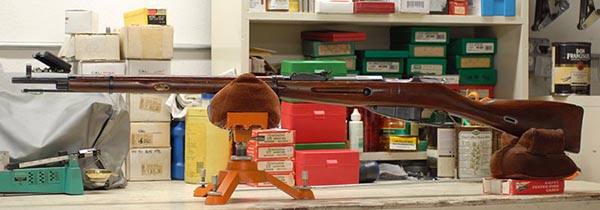

I shot the first two Mosins, and they were good shooters. Then I tried the Big Bear Tula, and at first, I thought the accuracy was terrible. My first shot was on the paper at 50 yards, but my second shot had missed the paper completely (that’s how it looked through the spotting scope). I fired a third round and that one was satisfyingly only about 3/8 of an inch away from the first. I walked downrange to inspect the target, and wowee!
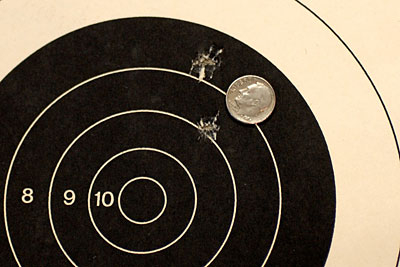
That second shot wasn’t off the paper…it went through the same hole as the first shot! Thinking that this was just a fluke, I fired another group of three shots, with similar results! Wowee again! With open sights, this was iron sight accuracy I just wasn’t used to. It was stellar. Bear in mind these were the first shots I had put through this rifle. I was elated.
Knowing that this Tula was a shooter, I took the rifle apart later that day to give it a good cleaning. I noticed the little nicks and dings you see when you do this sort of thing, including what looked like painted over weld spatter on the left exterior of the receiver. Even though Paul had explained the findings on his sniper rifle to me, it never occurred to me what I was working with. I didn’t think about sniper rifles; I just thought that due to this particular rifle’s condition it probably saw action in World War II and the Russian refurb arsenal did the best they could to clean it up. And I knew it was a shooter. The thing was just flat accurate. Amazingly so.
I snapped a bunch of photos when I reassembled the Tula, and here’s the money shot…
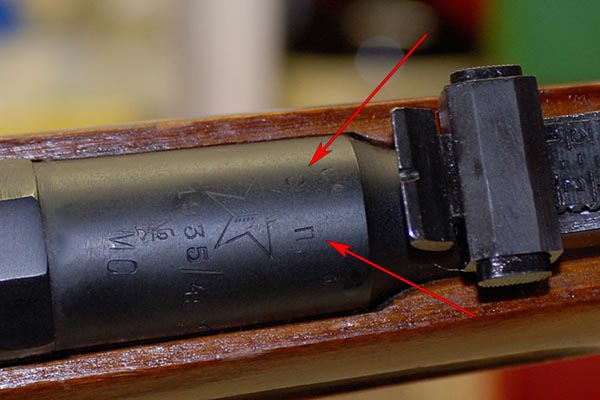
I didn’t know what all the markings on it meant; I simply liked the photo and I posted it on one of the Mosin Internet forums.
Well, the Mosin forum lit up, and the comments started pouring in. The first one was a simple one-word comment:
Sniper.
Hmmm. How do you know that, I posted, watching more comments pour in about my Mosin being a sniper.
It’s the markings that look like a C and an N, the forum dudes told me. One guy wrote “Look inside the receiver and you’ll see the two plugs on the left side…I know they’ll be there.”
Wow, before I even looked, it all came together for me. The weld spatter on the outside of the receiver. The overall condition of the rifle (rode hard, put away wet, definitely not pristine). I pulled the bolt back, looked inside, and there they were…the plugged holes where the sniper scope used to be. Awesome! I had hit the jackpot, just like Paul did!
So this whole Mosin Sniper thing really had my attention. I poked around on the Internet a bit more and these photos showed up…
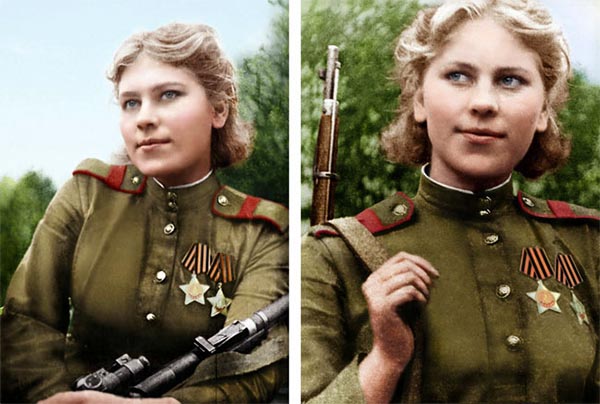
That’s Roza Shanina, “the unseen terror of East Prussia,” holding a Mosin-Nagant sniper rifle. She’s credited with 59 kills during World War II. Her story is fascinating and would make for a great book. It all sounds like a hell of a story.
You’ll notice there’s a scope on Roza Shanina’s rifle, which is what the sniper rifles had. The mount for it required two threaded holes on the receiver, the two holes the Russians plugged when they refurbed the rifles. The sniper rifles also had a longer, downturned bolt handle that allowed the shooter to work the bolt with the scope mounted. All very cool stuff. The Stephen Hunter novel references to a fictionalized Shanina are oblique and like most novels, some of the technical stuff is wrong. But it’s a great read.
You can still buy Mosin-Nagant rifles, but the prices are climbing sharply and these rifles are not as readily available as they were just two or three years ago That’s probably a good thing, because my credit card can stay hidden away in my wallet. But I still like to look, and if I see a Mosin on the rack in any gun store, I’ll check the receiver for the sniper markings and the two weld plugs where the scope used to be. I haven’t seen a single one since I scored mine, and that’s a satisfying feeling.
More Tales of the Gun!
Join our Facebook Milsurp target shooting group.
Never miss an ExNotes blog:

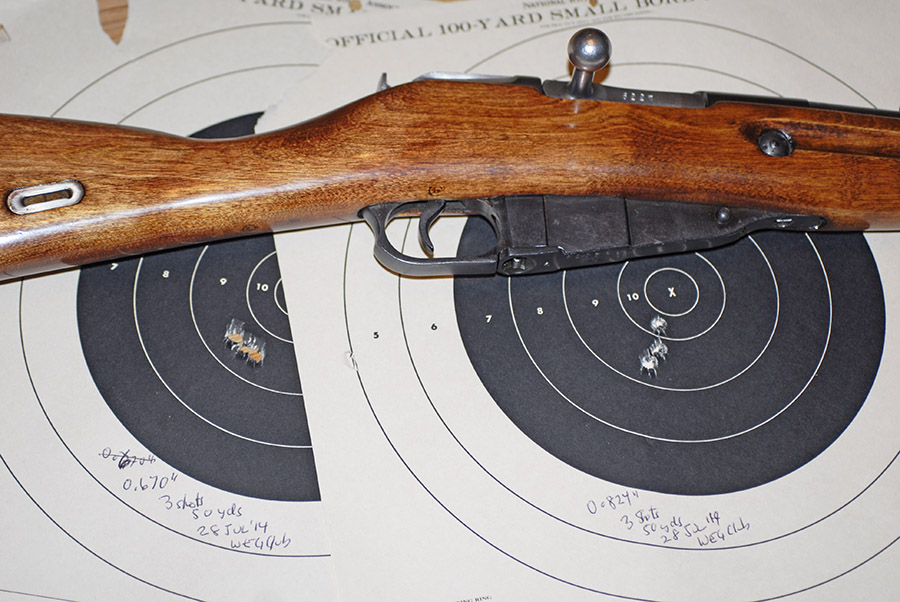
Interesting stuff, Joe, as always.
Are you familiar with Lyudmila Mikhailovna Pavlichenko, her 309 kills, and her friendship with Eleanor Roosevelt? The movie about her life “Battle for Sevastopol,” is pretty good, though I can’t attest to it’s accuracy.
Thanks, J. I have heard of Lyudmila Pavlichenko. I did not know she was friends with Eleanor Roosevelt. I’ll look for the movie you mention, and thanks for your comment!